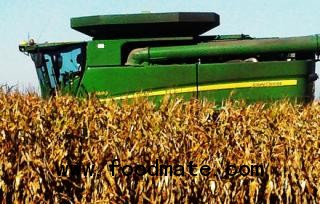
Since planting time, estimates for the total U.S. corn crop have fallen from just shy of 15 billion bushels to 10.8 billion in last month's Crop Production report.
Some say the corn crop, unlike the soybean crop for which there's still potential for improved yields, is made and yields aren't likely to see much of a drop in Wednesday's report. That doesn't necessarily mean things are stable, though, says U.S. Commodities market analyst and broker Don Roose. Instead, the market will likely be more focused on area.
"My gut feeling is that it's going to be more about the harvested acres. We could have them down, but yield not changed a lot," Roose says. "Ultimately, yield may go up but acres down. For soybeans, conditions are going up. With this report, you better be looking at both sides. We're knocking the premiums out of this market too."
The demand side of the equation looms just as large as the supply side right now, and there's already been a lot of rationing underway to trim grain needs more in step with yield potential. As of Wednesday's report, Roose says there's already been as much liquidation as possible in the cattle herd, but there's still room for more in the hog and poultry sectors. The demand rationing that's gone on, though, is likely enough to keep the market from exploding (barring any massive departures from the recent trend in yields and crop size).
"I would argue that the grain market is an underachiever. We've had bullish news since the third week of July and we haven't gone anywhere...in fact, sideways to down," Roose says.
Looking beyond Wednesday's report, initial market reactions and subsequent corn, soybean and wheat yield potential in South America, eastern Europe and North America will have the most to do with where prices move.
"I think demand's being rationed right now. If you go back far enough, how we've always bridged the gap with increased demand is increased yield," Roose says.
"Even if you have a corn crop under 10 billion bushels and a carryout that is 1 billion, you're going to strart out the marketing year with 11 billion bushels. The shortage is not today. It comes down the road. If you can bridge the gap long enough, you won't have that shortage."
"The market's job is going to run corn availability as harvest hits around the world. It just keeps going around the clock."
For now, watch how the market reacts to Wednesday's numbers. The initial reaction, Roose says, will indicate how close together demand and supply are. And, that will go a long way to determining how much prices could fluctuate -- up or down -- between now and next spring.
"If you get a corn number that's 119 bushels/acre, the market's called 20 cents higher and the market doesn't budge and ends up unchanged, you're dead in the water," he says.
Ahead of Wednesday's report, traders trimmed risk potential in late trading Tuesday, sending corn and soybeans to lower closing prices.





